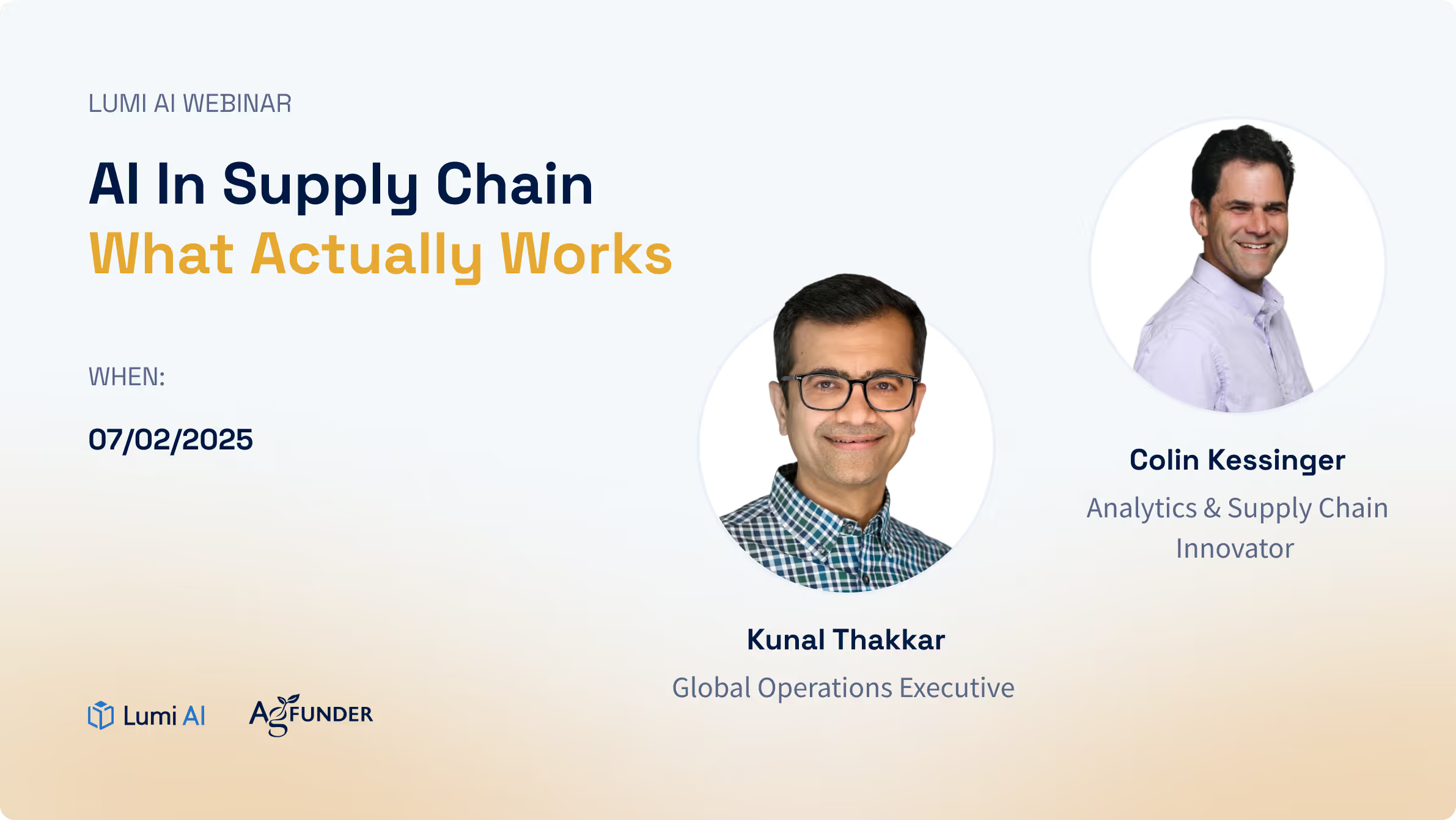Back to blog
Back to Case Studies
AI in Supply Chain: What Actually Works



Lumi AI Webinar: AI in Supply Chain
AI is becoming a cornerstone tool of how leading companies make smarter decisions, manage complexity, and respond faster to change. From manufacturers and logistics firms to retail giants, organizations are moving past dashboards and into true supply chain automation.
What this webinar uncovered
In this session, industry experts from Lumi AI and some of the world’s most experienced supply chain leaders break down how Generative AI is transforming supply chain operations today. The conversation moves from demand forecasting and inventory optimization to procurement and transportation management, focusing on real-world examples, measurable ROI, and the expanding need for cross-functional collaboration.
Key speakers include
• Ibrahim Ashqar (CEO, Lumi AI)
• Kunal Thakker (Walmart, Newegg, UPS, SEAIR Global)
• Colin Kessinger (End-to-End Analytics, Accenture, Stanford Lecturer)
These experts share practical insights and first hand lessons on implementing AI in supply chain management at scale. They also explore the common traps that companies fall into and unpack what McKinsey calls the GenAI paradox: when adoption grows but real business value stalls.
Seminar Key Takeaways
- ✅ Generative AI is showing real impact in supply chain operations
- ✅ The biggest gains come when GenAI is applied vertically with domain-specific knowledge
- ✅ Getting started doesn’t require a full transformation. Focus on quick wins that prove value, then scale
This conversation is all about moving from ideas to implementation, from promise to performance.
1. Impact of Generative AI in Supply Chain - Decisions over Visability
Many supply chain teams already have visibility tools. But visibility without decision-making power is just more data with no direction.
The real value of AI in supply chain planning comes when artificial intelligence helps teams decide what to do next. Whether it is reordering inventory ahead of demand, rerouting goods due to disruption, or adjusting workflows to prevent delays, AI enables action.
Generative AI and augmented analytics allow teams to shift from simply reporting what happened to understanding what will happen, and more critically, what to do about it.
Bottom line: To get value from AI in the supply chain context, the tool must help teams make decisions not just give visibility to a problem.
2. Biggest Gains from Vertical, Domain-Specific Use Cases
The most significant wins from AI in the supply chain aren’t coming from broad, generic applications—they’re coming from targeted, domain-specific use cases. A common misconception is that effective AI requires flawless data or a fully unified tech stack. In reality, the biggest gains are happening in verticals where teams focus on their most pressing, localized problems.
The truth is, companies seeing success are starting with specific and known pain points like supplier disruptions, demand volatility, stock outs, etc and solving them one by one.
Instead of asking for a 12-month AI roadmap, they are asking:
• What is the hardest decision we face today?
• Where do we lose the most time or accuracy?
• What daily operational challenge slows us down the most?
That’s where AI in supply chain and logistics delivers value: tackling operational bottlenecks that hurt performance every day.
Bottom line: The highest ROI from AI comes when solutions are tailored to the unique realities of your industry
3. Start Small - Prove Value - Scale Across
The most successful supply chain AI initiatives begin with one focused, high-impact use case. Starting small allows teams to avoid complexity, test the fit within existing workflows, and build early confidence without requiring a full transformation.
The goal is not to prove the model’s intelligence but to prove its value. When AI tools are fast, intuitive, and aligned with how teams already operate, they drive measurable outcomes. Once trust and impact are established, scaling becomes natural. Organizations can extend successful solutions across adjacent functions, geographies, or business units. This is the approach used by industry leaders: not forcing adoption, but expanding it based on clear operational wins.
That is how companies like Walmart and UPS are seeing success, not by forcing transformation, but by enhancing workflows teams already trust.
Bottom line: The key to success with AI in supply chain is to start small, prove it works, and only then scale with confidence.
Where AI Is Delivering Real Value in Supply Chain Today
If you are wondering how AI is being used in supply chain, here are the areas where it is having the greatest impact:
- Demand forecasting and inventory planning: Still the most consistent and high-impact use case for artificial intelligence in supply chain operations
- Operational automation: Especially in high-volume, repetitive decisions where speed and precision are critical
- Supply chain visibility with action: Dashboards are not enough, AI must lead to proactive movement and improved decision flow
- Food and beverage analytics: Gaining traction in fast-moving retail environments with constantly shifting demand and inventory dynamics
The leaders in AI are teams that adopt AI pragmatically: starting small, proving impact, and expanding based on real business value.
In Short
- Start with decisions, not dashboards
- Fix one real workflow before redesigning your system
- Make the tool feel like part of your team
Resources
- McKinsey - Seizing the Agentic AI Advantage (June 2025)
- OpenAI - AI in the Enterprise (April 2025)
- McKinsey - the State of AI (March 2025)
- Lumi AI - Agentic Workflows (March 2025)
- Deloitte - State of Gen AI in the Enterprise (Jan 2025)
Missed the session?
You can still watch the full recording or view full transcript to learn how the most innovative teams are applying artificial intelligence in supply chain management to move from reactive operations to proactive advantage.
At Lumi, we’re helping supply chain teams move from siloed data to automated workflows using AI, fast, and without replacing their existing tools.
If you're exploring how predictive analytics or retail analytics could actually work inside your operations, let’s talk

Make Better, Faster Decisions.






